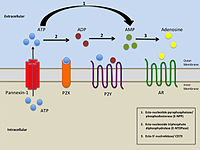
Photo from wikipedia
The A2B adenosine receptor is a G protein-coupled receptor that belongs to the four member family of adenosine receptors: A1, A2A, A2B, A3. While adenosine-mediated A2B receptor signaling attenuates acute… Click to show full abstract
The A2B adenosine receptor is a G protein-coupled receptor that belongs to the four member family of adenosine receptors: A1, A2A, A2B, A3. While adenosine-mediated A2B receptor signaling attenuates acute inflammation, facilitates tissue adaptation to hypoxia, and induces increased ischemia tolerance under conditions of an acute insult, persistently elevated adenosine levels and A2B receptor signaling are characteristics of a number of chronic disease states. In this report we describe the discovery of certain thienouracils (thieno[2,3-d]pyrimidine-2,4(1H,3H)-diones) as antagonists of the A2B adenosine receptor by high-throughput screening from our corporate substance collection. The structure optimization of the initial screening hits led to BAY-545, an A2B receptor antagonist that was suitable for in vivo testing. The structure optimization work, SAR that was derived from there, as well as the properties of BAY-545 are also described. In vivo efficacy of BAY-545 was demonstrated in two models of lung fibrosis and data is presented.
Journal Title: European journal of medicinal chemistry
Year Published: 2019
Link to full text (if available)
Share on Social Media: Sign Up to like & get
recommendations!